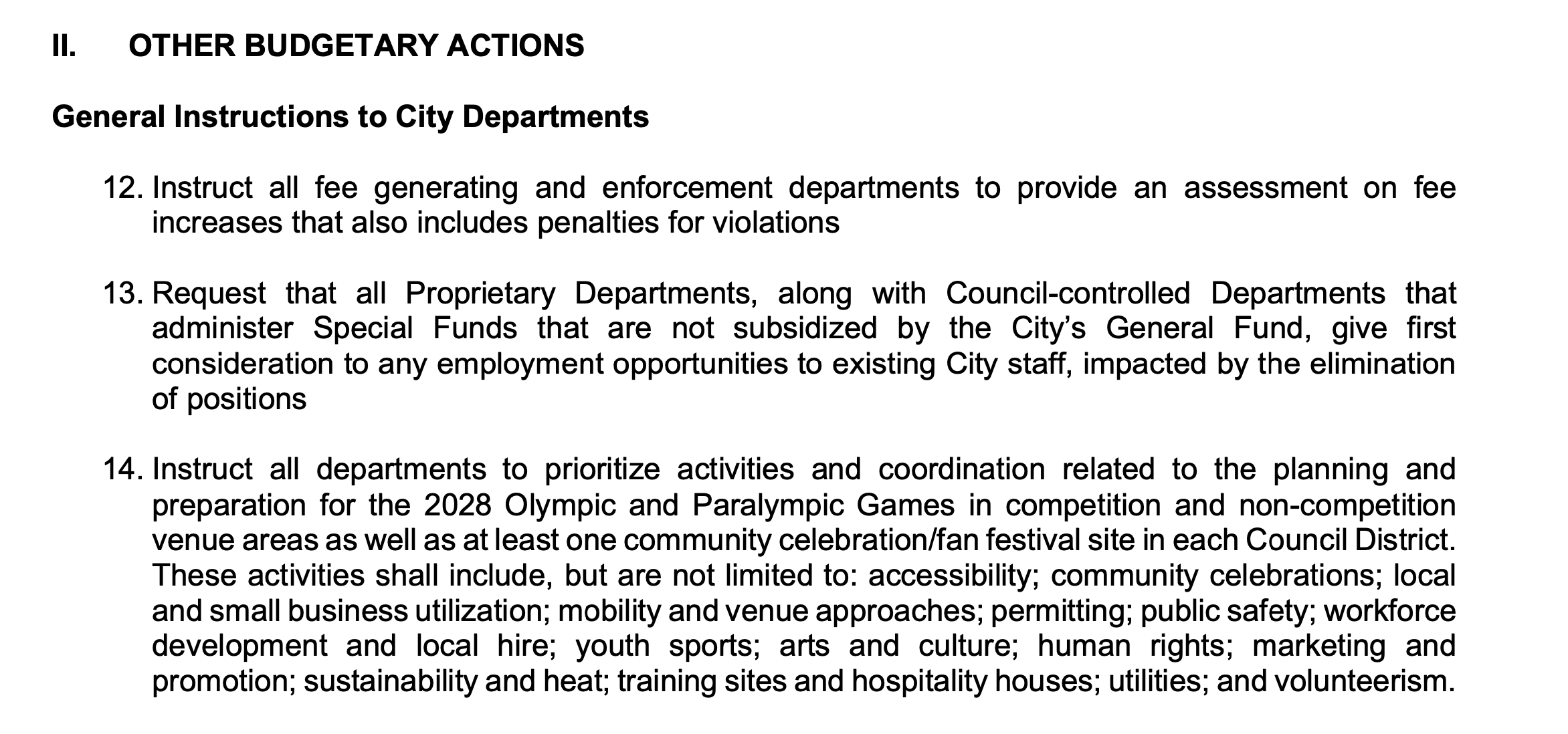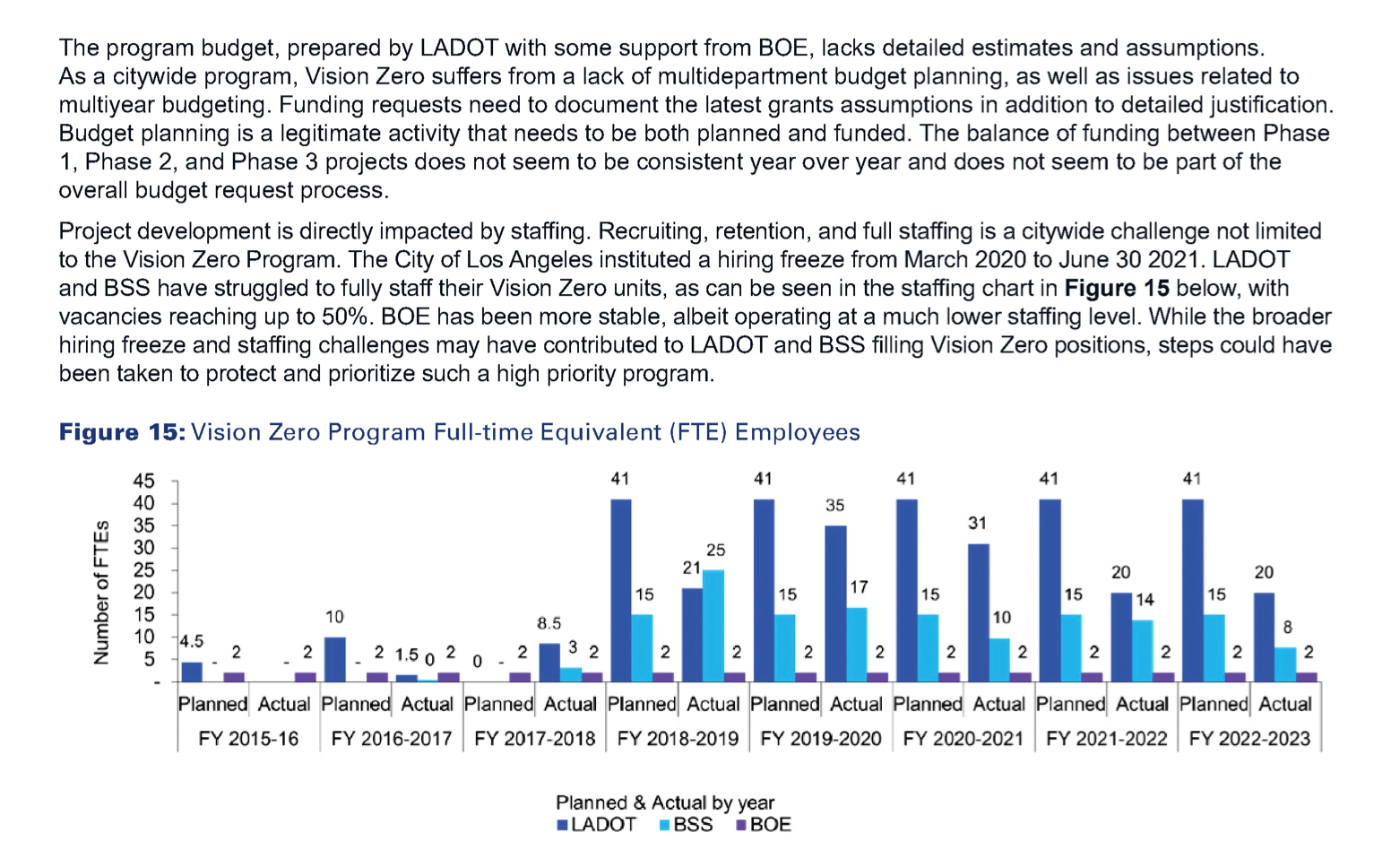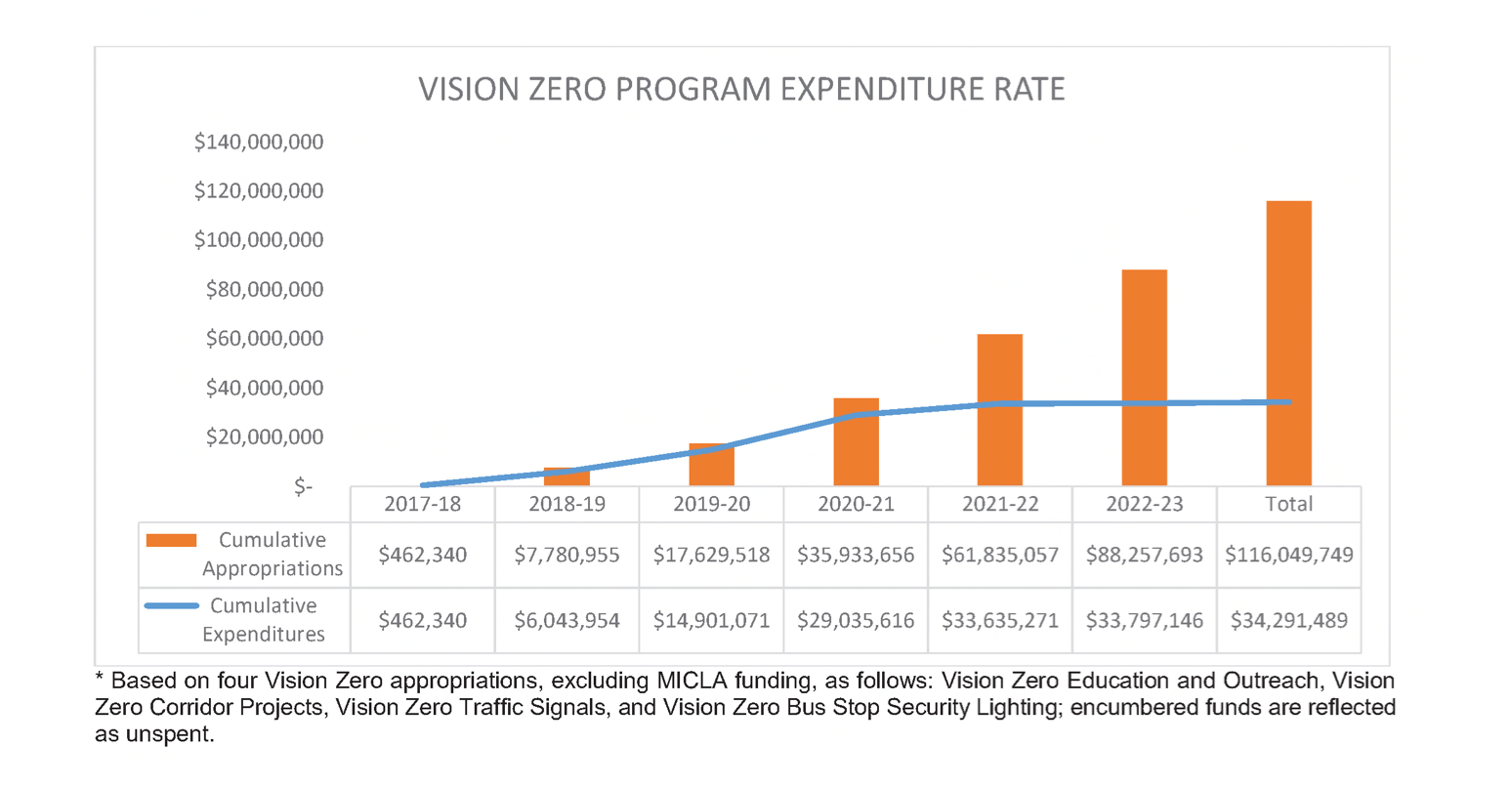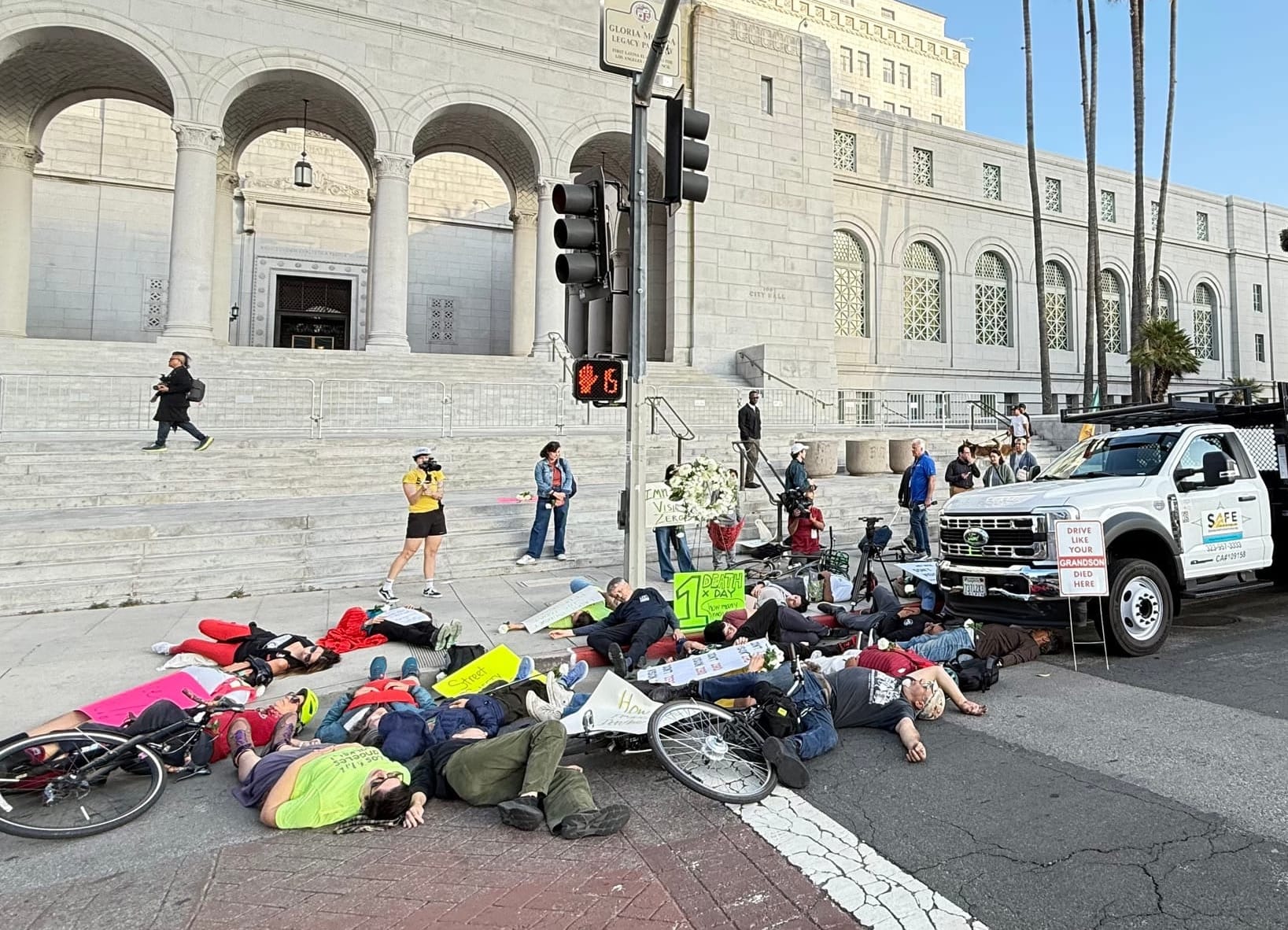The Grand scheme
This is the downtown that Frank Gehry wanted. When will LA's leaders give it to us?
During this week's budget hearings, councilmembers repeatedly asked if improvements around Olympics venues were taking precedence over obligations to their constituents to deliver safer streets

Bodies were strewn in the street. Bikes were scattered horizontally across the curb. A helmet was wedged beneath the wheels of a large truck. For 303 seconds, transportation advocates laid motionless in front of City Hall, honoring the 303 lives lost to traffic violence on LA’s streets in 2024 — or, as a neon green sign broke down the math: nearly one death a day. A white sheet draped over the truck spelled out a message in red spray paint to the legislators in their offices above, the letters dripping like blood: LA Mayor's budget = more traffic deaths.
At the bullhorn was Damian Kevitt, the executive director of Streets Are For Everyone, presiding over a scene that eerily recalled a transformative moment in his own life. In 2013, Kevitt was riding his bike through Griffith Park when he was hit by the driver of a car. Trapped beneath the vehicle, which did not stop, Kevitt was dragged nearly a quarter-mile onto the 5 freeway. "Two years later, Los Angeles leaders announced a bold Vision Zero goal: to eliminate traffic deaths by 2025," Kevitt wrote in a Change.org petition which includes a photo of himself in the hospital, his right leg amputated below the knee. "But nearly a decade later, traffic violence has only gotten worse."
In March, I wondered if our billion-dollar deficit would mean that Olympics-focused transportation projects would be prioritized over other much-needed transportation safety projects. But when LA Mayor Karen Bass released her budget, the transportation department was the hardest-hit: over 400 positions, or 24 percent of the staff, are targeted for elimination. Now Laura Rubio-Cornejo, LADOT's general manager, is projecting a more dire reality: there won't be enough staffers to implement the Olympics-focused projects, either. "This budget will make it impossible for us to deliver on the city's 2028 games mobility objectives," she said during this week's budget hearings, "whether that is achieving a 'car-free' event or facilitating safe and orderly vehicle access through planned road closures and traffic control services."
Pay special attention to that last part. Rubio-Cornejo isn't just suggesting that we'll have to downgrade from "car-free" to "transit-first." She's saying neither of those options will be possible if this budget zeroes out the LADOT traffic officers who manage the city's events. And it's not just the megaevents that are at risk; the smaller events are, too. That's right: there's a possibility of no more open streets.
"LA mayor's budget kills CicLAvia" is a pretty indicting headline, but this week's protest went one step further. At Kevitt's direction, advocates marched down Spring Street chanting: "LA mayor's budget will kill us!"
“LA mayor’s budget will kill us!” A coalition of about 50 safe streets advocates are staging a die-in on the steps of City Hall and marching to LADOT to protest the mayor’s budget proposal that eliminates about 25% of the city’s transportation staff
— Alissa Walker (@awalkerinla.bsky.social) 2025-05-01T01:42:31.935Z
For the last two years, the number of traffic fatalities has exceeded the number of homicides in the city of LA. In 2024, voters passed Measure HLA by a wide margin, forcing the city to make streets safer and more multimodal. Most councilmembers — not all, but most — responded by accelerating projects with bus lanes, protected bike lanes, and sidewalks with ADA improvements like curb ramps. New bike infrastructure quickly installed in Hollywood is already slowing cars and boosting bus ridership.
But during this week's budget hearings, councilmembers repeatedly asked if improvements around Olympics venues were taking precedence over obligations to their constituents to deliver safer streets. "I had a lot of projects I felt were moving but are being deleted," said Councilmember Bob Blumenfield. "None are near venues of the 2028 games. But my constituents, I feel that they're also entitled to safe and accessible streets and sidewalks."
When Blumenfield asked Rubio-Cornejo directly if any of the safety improvements would be made in his Valley district far away from the Olympics action, she confirmed that they would not: "At reduced staffing levels as proposed within the budget, if we were directed to only focus on games delivery that is likely the only thing we would be able to do."
And, as it turns out, that exact direction to department heads — to prioritize megaevent planning over everything else — is right there in the mayor's budget:

As labor representatives pointed out more than once during the budget hearings, there has been no transparency about why certain positions were eliminated by the Office of the City Administrative Officer, referred to as the CAO, which puts together the mayor's budget. Multiple city staffers described the cuts to me as "DOGE-like," which was also incorporated into the die-in's official title: Don’t "DOGE" LA Safety. Staffers claim the CAO slashed positions arbitrarily without considering department recommendations — and department heads had plenty to say about this in their letters to the budget committee.
And now those managers are being instructed to prioritize planning for 2028 — with insufficient staffing, reduced resources, and no agreed-upon plan.
Oh right, that's the other thing confirmed by these budget hearings: there is no strategic plan for 2028 — at least, not yet. But Torched readers already knew that.
Councilmember Katy Yaroslavsky asks about resources for Olympics planning at today's budget hearings. KYY: "Is there an official strategic plan?" Deputy Mayor Matt Hale: "The investments we're making this year are headed in the direction of developing that plan." In other words, there's no plan
— Alissa Walker (@awalkerinla.bsky.social) 2025-04-29T23:56:31.044Z
The bloodbath at LADOT comes during what should be turning point for the department — just a few weeks after a damning audit of the city’s Vision Zero initiative detailed the program's failure to reduce traffic deaths. A decade later, we have a city that's somehow more dangerous for pedestrians, who now count for over half of the total annual road fatalities. Some communities are more severely impacted than others: 22 percent of the crashes that resulted in deaths or serious injuries happened in just two council districts, 8 and 9, which also have the city's highest numbers of Black and Latino residents.
To change this, the audit calls for a "cohesive long-term capital program planning process," a favorite topic here at Torched. (Say it with me: C-I-P!) While a capital plan is just starting to come together, the audit also calls for properly staffing the departments. The 2018 budget was the first to incorporate the goals of Vision Zero, at least on paper. That jump in planned full-time LADOT employees you see in the chart below is the level of staffing that the department said it needed to make significant progress towards eliminating traffic deaths. The city never gave it to them.

Looking at the subsequent years, you might think, well, of course. There was the pandemic, a lot of economic uncertainty, a hiring freeze. Surely the city was financially strained.
But that's the thing: the transportation department is particularly skilled at bringing in revenue, return funds, and grants — the Vision Zero program has the money!

According to the CAO's own report on the audit, much of the allocated Vision Zero money has not yet been spent, "primarily due to the majority of funding being allocated toward engineering activities, which take multiple years to plan, construct, and require coordination." In other words, what Vision Zero needs is pretty simple: more full-time employees who can work together with other full-time employees at other departments to build streets that save lives faster.
When LA's Vision Zero initiative was announced by the previous mayor in 2015, the city was already bidding for the Olympics, which, at the time, we thought we'd be hosting in 2024. A goal to eliminate traffic deaths by 2025 dovetailed nicely with a goal to build safer, more multimodal streets just as millions more people were coming here to use them. The list of improvements being made for 2028 — which you can see here — are still good safety improvements we should make as a city. They check both boxes. But we can't keep publicly saying we want "car-free" games and "zero-death" streets until we've come to a collective agreement that our transportation system is going to stop murdering our most vulnerable Angelenos.

The city's Vision Zero audit was completed in December 2023. It does not include the 2023 data, the deadliest year on LA's streets in 20 years. The CAO then took 16 months to produce recommendations released on April 11 — too late to be reflected this year's budget. In the face of other emergencies — and we certainly do have a lot of them, I know — Bass has fought to reallocate staff and resources. But our mayor has not yet seemed to grasp that she alone can change the trajectory of this crisis, too. Our mayor could guarantee that more Angelenos aren't grieving the loss of a family member a year from now. Our mayor knows that feeling better than anyone. In 2006, Bass's own daughter and son-in-law were killed in a fiery car crash.
On Wednesday, after the die-in portion of the protest, advocates began their funeral march to LADOT headquarters cradling a wreath of white roses. Kevitt took a moment to point out that the city's flag was also part of the procession. In the same way an inverted American flag had recently been unfurled in prominent national parks as a distress signal, LA's flag was also being flown upside down, he said. "The city of LA is in distress." 🔥